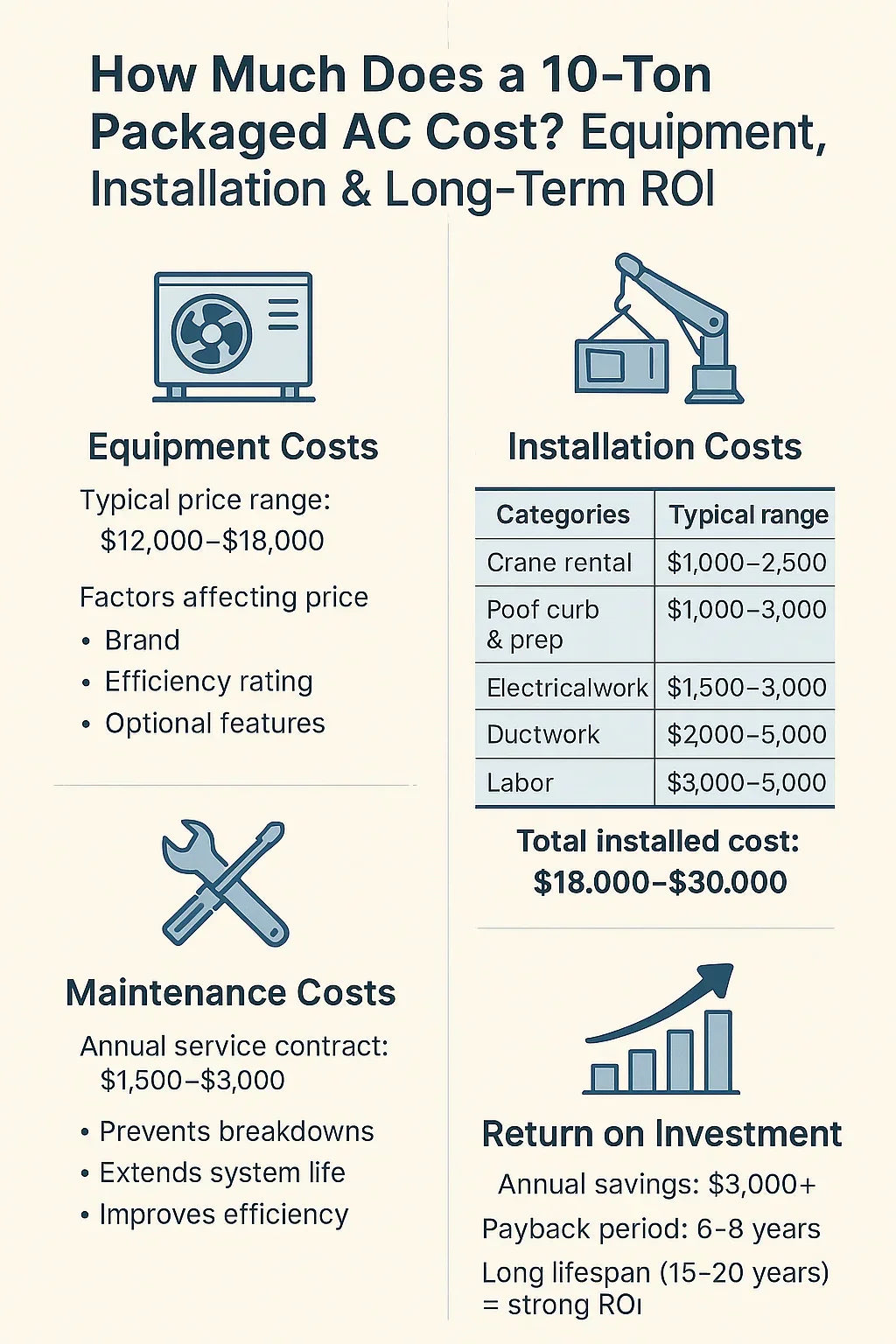For many businesses, upgrading or installing a 10-ton packaged rooftop air conditioner (RTU) is one of the biggest capital investments they’ll make in building operations. These systems provide reliable, large-scale cooling, but the true cost isn’t just about the sticker price of the equipment.
To make a smart, ROI-driven decision, you need to understand:
👉 How much the equipment itself costs
👉 What drives installation expenses
👉 The ongoing operating and maintenance costs
👉 How rebates, tax incentives, and efficiency savings affect ROI
This guide breaks it all down—so you can budget accurately, avoid hidden costs, and calculate the long-term return on your investment.
📦 Equipment Costs: What You’ll Pay Upfront
The starting point for any budget is the equipment itself.
Typical Price Range
-
$12,000–$18,000 for a new 10-ton packaged rooftop unit (RTU).
This covers the cabinet containing the compressor, condenser, evaporator coil, blower, and controls in one self-contained system.
Factors That Affect Equipment Price
-
Brand
-
Daikin: Known for energy-efficient, high-IEER2 models.
-
Trane: Premium durability, slightly higher price.
-
Carrier: Balanced performance, strong service network.
-
-
Efficiency Rating
-
Units rated with IEER2 (Integrated Energy Efficiency Ratio 2) determine energy savings.
-
Higher IEER2 = higher upfront cost, but lower utility bills.
-
-
Configuration & Options
-
Economizers for free cooling using outdoor air.
-
Gas/electric hybrid heating add-ons.
-
Smart controls for building automation systems (BMS).
-
👉 Example: A Daikin 10-ton, 15 IEER2 packaged AC will cost more upfront than a baseline 13 IEER2 competitor—but may save $3,000/year in energy costs.
📖 Reference: Daikin Applied – Packaged Rooftop Units
🏗️ Installation Costs: Beyond the Equipment
Many businesses underestimate installation expenses. In reality, installation often equals—or even exceeds—the equipment cost.
Common Installation Cost Categories
| Category | Typical Range | Notes |
|---|---|---|
| Crane rental | $1,000–$2,500 | Needed to lift RTU to rooftop |
| Roof curb & prep | $1,000–$3,000 | Custom curb, flashing, roof reinforcement |
| Electrical work | $1,500–$3,000 | 208/230V 3-phase, breaker, disconnect |
| Ductwork modifications | $2,000–$5,000 | Sealing, resizing, custom sheet metal |
| Labor | $3,000–$5,000 | HVAC crew time, typically 2–3 days |
Total Installed Cost
$18,000–$30,000 for a full equipment + installation package.
What Makes Installation More Expensive?
-
Accessibility
-
If the building has limited crane access, costs rise (permits, street closures, larger cranes).
-
-
Roof Condition
-
If the roof can’t support the RTU, reinforcement is required.
-
-
Retrofit vs. New Construction
-
Replacing an old RTU often requires duct modifications.
-
New buildings may save since ductwork is already designed for the system.
-
📖 Reference: HVAC Cost Guide
⚡ Operating Costs: Energy Efficiency & Monthly Bills
A 10-ton packaged AC consumes a lot of power—so operating costs quickly become the biggest factor in total ownership.
How Energy Efficiency Affects Bills
-
Cooling capacity: 120,000 BTUs/hour.
-
Old units (8–10 IEER): $12,000–$14,000/year in cooling costs.
-
Modern high-efficiency (15 IEER2): ~$9,000/year.
👉 Annual savings: $3,000–$5,000 by upgrading.
Example: Daikin 15 IEER2 vs. 12 IEER2 Competitor
-
Annual run time: ~2,000 hours (typical for U.S. office space).
-
Energy cost per kWh: $0.12 (national average).
-
Daikin 15 IEER2 → 20%+ less energy consumed.
-
Payback in 6–8 years just on efficiency.
📖 Reference: ENERGY STAR – Commercial HVAC Efficiency
🧾 Maintenance Costs: Protecting Your Investment
A new RTU isn’t a “set it and forget it” system. Ongoing maintenance is essential to keep efficiency high and extend lifespan.
Typical Maintenance Expenses
-
Annual service contract: $1,500–$3,000/year.
-
Includes filter changes, coil cleaning, electrical inspections, refrigerant checks.
What Happens If You Skip Maintenance?
-
Dirty coils increase energy use by 10–20%.
-
Missed refrigerant leaks can destroy compressors ($5k–$7k repair).
-
Lifespan drops from 15–20 years → 8–12 years.
👉 Preventative maintenance = $1 saves $3–$5 in energy + repair costs.
📖 Reference: ASHRAE – Preventive Maintenance Guidelines
🎁 Rebates, Incentives & Tax Deductions
One of the most overlooked parts of HVAC budgeting: incentives.
Federal & State Incentives
-
DSIRE database lists local rebates for high-efficiency RTUs.
-
Utility providers often offer $500–$2,500 per unit for ENERGY STAR-qualified systems.
Tax Deduction: Section 179D
-
Commercial building owners may deduct up to $5 per sq. ft. for energy-efficient upgrades (per Inflation Reduction Act updates in 2023).
Example
-
Installed cost: $25,000
-
Utility rebate: $2,000
-
Section 179D deduction: $15,000 (based on building size)
-
Net effective cost: $8,000 less
📖 Reference: DSIRE – Energy Incentives Database
📈 Long-Term ROI: The Payback Equation
Here’s a simplified ROI scenario for a business investing in a Daikin 10-ton RTU:
-
Installed cost: $25,000
-
Annual energy savings: $3,000 (vs. old system)
-
Annual maintenance: $2,000
-
Net annual benefit: $1,000 savings + improved comfort + reduced downtime
-
Rebates/incentives: $2,500 upfront
👉 Payback period: ~7.5 years
👉 System lifespan: 15–20 years
Meaning: After payback, you’re enjoying 8–12 years of net savings.
🏆 Key Takeaways
-
Equipment: $12k–$18k
-
Installation: $6k–$12k
-
Total Installed Project: $18k–$30k
-
Operating Costs: $9k–$12k/year (lower with high efficiency)
-
Maintenance: $1.5k–$3k/year
-
ROI: 6–8 years payback with incentives
👉 A Daikin 10-ton packaged rooftop AC isn’t just an equipment upgrade—it’s a long-term financial strategy. When properly installed and maintained, it pays for itself in energy savings, tax incentives, and reliability.
In the next topic we will know more about: Do 10-Ton Packaged ACs Qualify for Rebates or Tax Incentives in 2025?







